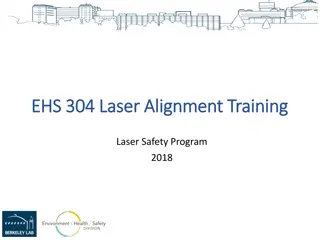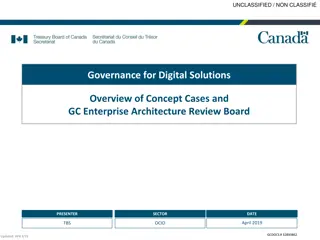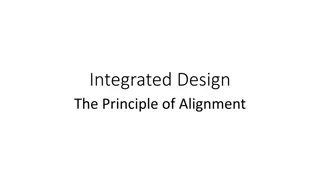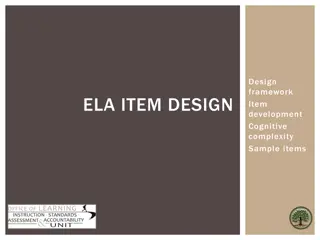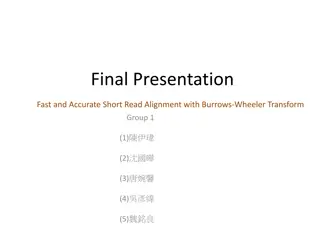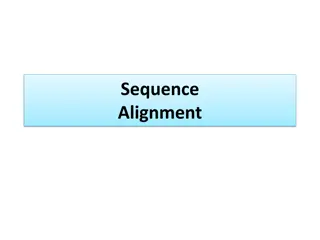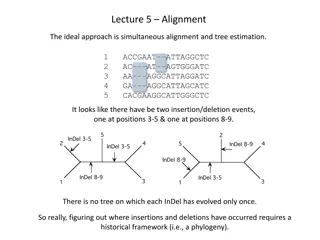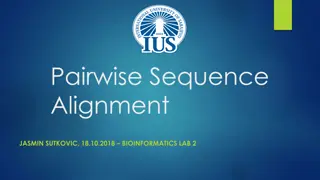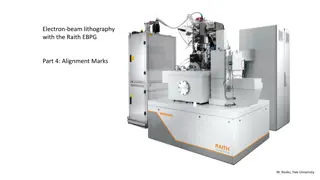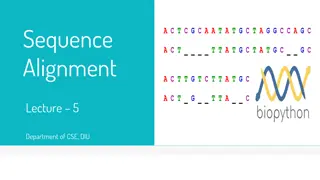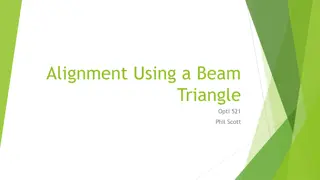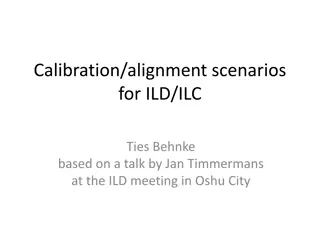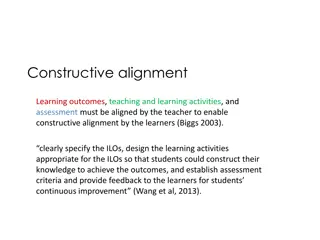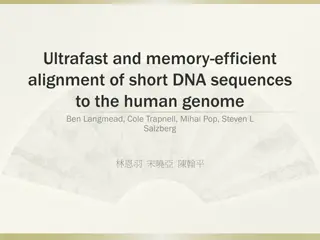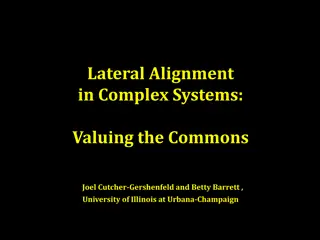
Bioinformatics Alignment Approaches and Pitfalls
Explore bioinformatics alignment approaches, pitfalls, and solutions in the context of genomics research. Learn about the challenges of read alignment to reference genomes and the smart solutions to improve accuracy and efficiency in sequencing data analysis.
Download Presentation

Please find below an Image/Link to download the presentation.
The content on the website is provided AS IS for your information and personal use only. It may not be sold, licensed, or shared on other websites without obtaining consent from the author. If you encounter any issues during the download, it is possible that the publisher has removed the file from their server.
You are allowed to download the files provided on this website for personal or commercial use, subject to the condition that they are used lawfully. All files are the property of their respective owners.
The content on the website is provided AS IS for your information and personal use only. It may not be sold, licensed, or shared on other websites without obtaining consent from the author.
E N D
Presentation Transcript
DTU Health Technology Bioinformatics Alignment Gisle Vestergaard Associate Professor Section of Bioinformatics Technical University of Denmark gisves@dtu.dk
Menu Alignment approaches Burrows-Wheeler Transform Read depth SAM/BAM Alignment 30. september 2020 DTU Sundhedsteknologi 3
Generalized NGS analysis Alignment 30. september 2020 DTU Sundhedsteknologi 4
Alignment/Mapping Sometimes we have specific genomes of interest Sometimes we have specific genes of interest Assemble your reads by aligning them to a closely related reference genome Reads Genome Alignment 30. september 2020 DTU Sundhedsteknologi
Sounds easy? Some pitfalls: Divergence between sample and reference genome Repeats in the genome Recombination and re-arrangements Poor reference genome quality Read errors Regions not in the ref. genome Contaminated sample Alignment 30. september 2020 DTU Sundhedsteknologi
Simplest solution Exact string matches: Reference: ACGTGCGGACGCTGAACGTGACG Read: GTG GTG G TG GTG We need to allow mismatches/indels (Smith-Waterman, Needleman-Wunsch) One of the worlds fastest computer (K computer - RIKEN) 20 mill reads 100 nt reads vs. human genome ~ 1 month We search each read vs. the entire reference Alignment 30. september 2020 DTU Sundhedsteknologi
How about BLAST? Everybody uses BLAST Everybody will believe your BLAST hits (pun intended) What we can learn: Reducing the search space However BLAST finds local alignments - not always what we want for short reads and other stuff (alignment scores, output format, speed Alignment 30. september 2020 DTU Sundhedsteknologi
Smart solution 1. Use algorithm to quickly find possible matches 3.2Gb Drastically reduced search space X possible matches 2. Allow us to perform slow/precise alignment for possible matches (Smith-Waterman) 1 best match Alignment 30. september 2020 DTU Sundhedsteknologi
Hash based algorithms Lookups in hashes are fast! Key . . . Value . . . 1. Index the reference using k-mers. 2. Search reads vs. hash k-mers 3. Perform alignment of entire read around seed 4. Report alignments ACTGCGTGTGA ACTGCGTGTGC ACTGCGTGTGT . . . Chr1_pos1234; Chr2_pos567 Chr7_posX Chr7_posZ; ... . . . Also known as Seed and extend Alignment 30. september 2020 DTU Sundhedsteknologi
Spaced seeds Key/k-mer is called a seed BLAST uses k=11 and all must be matches 11111111111 L = 11, 11 matches Smarter: Spaced seeds (only care about 1 in seed) Higher sensitivity 111010010100110111 L = 18, 11 matches Alignment 30. september 2020 DTU Sundhedsteknologi
Multiple seeds & drawbacks One could require multiple short seeds Instead of extending around each seed, extend around positions with several seed matches Drawbacks of hash-based approaches: Lots(!) of RAM to keep index in memory (hg ~48Gb!) Alignment 30. september 2020 DTU Sundhedsteknologi
Burrows-Wheeler Transform (BWT) Reversible compression of data Transform stores data using lexicographical (alphabetical) sorting Sorted data reduces search space! Allows compression because characters cluster together Ringeren_I_Ringe_ringer_ringere_end_ringeren_ringer_i_Ringsted$ $d__ _nIiernerdenrgtrr_gggggnnnnnnn_RrrrRrReeeiiiiiiieeeee____gs Reversible nature means we can recreate the sequence around known locations Alignment 30. september 2020 DTU Sundhedsteknologi
BWT for alignment BWT used in many alignment implimentations and allows We only need to store some locations We can calculate missing parts on the fly Sorted means fast! Compressed means less memory! Human genome can be effectively indexed and searched using 3Gb RAM! Alignment 30. september 2020 DTU Sundhedsteknologi
Two implementations in BWA Burrows Wheeler Aligner (BWA) can use: Read bwa aln: First ~30nt of read as seed Seed Extend around positions with seed match For short reads bwa mem: Multiple short seeds across the read Read Extend around positions with several seed matches Seeds For longer reads Alignment 30. september 2020 DTU Sundhedsteknologi
Single vs. Paired alignment Always get paired end reads (if possible) Can map across repeats Less mapping errors ? Unmapped read can be rescued by a good aligning mate Alignment 30. september 2020 DTU Sundhedsteknologi
Coverage of reference genomes Coverage/depth is how many times that your data covers the genome (on average) Example: N: Number of reads: 5 mill L: Read length: 100 G: Genome size: 5 Mbases C = 5*100/5 = 100X On average there are 100 reads covering each position in the genome Alignment 30. september 2020 DTU Sundhedsteknologi
Actual depth We aligned reads to the genome - how much do we actually cover? ~90X 50% Avg. depth ~ 90X Range from 0-250X Only 50% of the genome was covered with reads Alignment 30. september 2020 DTU Sundhedsteknologi
SAM/BAM format Sequence Alignment / Map format BAM = Binary SAM and zipped - always convert to BAM Two sections Header: All lines start with @ Alignments: All other lines Alignment 30. september 2020 DTU Sundhedsteknologi
SAM - Example Alignment 30. september 2020 DTU Sundhedsteknologi
Exercise time! http://teaching.healthtech.dtu.dk/22126/index.php/Alignment_exercise Alignment 30. september 2020 DTU Sundhedsteknologi



